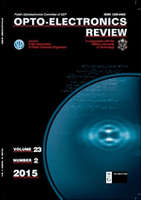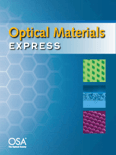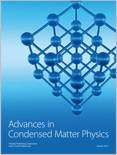
Optoelectronics and Advanced Materials-Rapid Communications
Scope & Guideline
Transforming Ideas into Impactful Research in Optoelectronics.
Introduction
Aims and Scopes
- Optoelectronic Device Development:
Research on the design, fabrication, and optimization of various optoelectronic devices such as LEDs, solar cells, lasers, and sensors. This includes studies on novel materials, device architectures, and performance enhancement mechanisms. - Nanomaterials and Nanocomposites:
Investigation into the synthesis, properties, and applications of nanomaterials and nanocomposites in optoelectronic applications. This area explores the unique properties of nanoscale materials and their potential for improving device performance. - Theoretical and Computational Modeling:
Utilization of theoretical approaches and computational modeling to predict and analyze the behavior of optoelectronic materials and devices. This includes first-principles calculations, simulations of optical properties, and modeling of electronic processes. - Advanced Characterization Techniques:
Application of cutting-edge characterization methods such as spectroscopy, microscopy, and electrical measurements to understand the properties and behaviors of materials at the microscopic and nanoscopic levels. - Photonics and Optical Communication:
Research focused on photonic systems, including fiber optics, free-space optics, and integrated photonic circuits. This area addresses challenges in optical communication systems and seeks to enhance data transmission capabilities.
Trending and Emerging
- Integration of Nanotechnology:
There is a significant increase in research integrating nanotechnology within optoelectronic devices. This includes the use of nanostructured materials to enhance device performance, such as improving light absorption in solar cells or increasing the efficiency of LEDs. - Sustainable and Green Photonics:
Increasing emphasis on environmentally friendly materials and processes in optoelectronic applications. Research is trending towards developing sustainable materials and energy-efficient devices, reflecting global concerns about sustainability. - Machine Learning and AI in Optoelectronics:
Emerging applications of machine learning and artificial intelligence techniques for optimizing device performance and material discovery. This trend shows potential for significant advancements in the speed and efficiency of research in optoelectronics. - Advanced Photonic Structures:
Growing interest in complex photonic structures, including metamaterials and photonic crystals, which can manipulate light in novel ways. This area is rapidly expanding, with applications in sensing, imaging, and telecommunications. - Hybrid and Multifunctional Devices:
Development of hybrid devices that combine multiple functions or materials to achieve superior performance. This trend highlights a move towards multifunctionality in optoelectronic applications, such as integrating sensing and communication capabilities.
Declining or Waning
- Traditional Optical Materials:
Research focusing solely on conventional optical materials without the incorporation of novel or advanced materials has decreased. This shift suggests a move towards exploring more innovative materials and composites that offer enhanced functionalities. - Basic Theoretical Studies:
There has been a decline in purely theoretical studies that do not integrate experimental validation or application. The trend indicates a preference for research that combines theory with practical applications, emphasizing results that can be experimentally verified. - Low-Impact Sensor Technologies:
Development of basic sensor technologies that do not leverage advanced materials or new methodologies has seen reduced interest. Researchers are gravitating towards sensors that utilize nanotechnology or advanced materials for improved sensitivity and specificity.
Similar Journals

OPTO-ELECTRONICS REVIEW
Pioneering Research in Optoelectronic Materials and ApplicationsOPTO-ELECTRONICS REVIEW, published by the Polish Academy of Sciences, is a prestigious peer-reviewed journal that has been at the forefront of research in the fields of electrical and electronic engineering, materials science, and radiation since its inception in 1996. With an ISSN of 1230-3402 and an E-ISSN of 1896-3757, the journal serves as a vital platform for disseminating high-quality research that explores the intersection of optoelectronics with cutting-edge technological advancements. Operating from its headquarters in Warsaw, Poland, OPTO-ELECTRONICS REVIEW reaches an international audience, contributing significantly to the body of knowledge in its categorically ranked quartiles, specifically Q3 in Electrical and Electronic Engineering and Materials Science for 2023. Researchers will find valuable insights as the journal continues to embrace emerging trends while maintaining rigorous academic standards. Although currently not open access, the journal remains an essential resource for professionals and students seeking to enhance their understanding and application of optoelectronic technologies.

Optical Materials Express
Fostering collaboration in the science of light and materials.Optical Materials Express is a leading open-access journal dedicated to the rapid dissemination of research in the field of optical materials, published by the esteemed Optica Publishing Group. Since its inception in 2012, the journal has played a pivotal role in advancing knowledge and innovation in Electronic, Optical, and Magnetic Materials, currently maintaining a commendable Q2 classification in the 2023 category rankings. With a Scopus rank of 86 out of 284 in its category, the journal proudly boasts a 69th percentile positioning, underscoring its impact and relevance within the scientific community. The journal publishes high-quality, peer-reviewed articles that explore both fundamental and applied aspects of optical materials, making it an essential resource for researchers, professionals, and students alike. Located in Washington, DC, and accessible to a global audience, Optical Materials Express continues to foster collaboration and innovation among scholars in this vibrant field.

Nanoscience and Technology-An International Journal
Pioneering Research at the NanoscaleNanoscience and Technology-An International Journal, published by BEGELL HOUSE INC, is a leading platform dedicated to the rapidly evolving fields of nanoscience and nanotechnology. With its ISSN 2572-4258 and E-ISSN 2572-4266, the journal serves as a crucial resource for researchers, professionals, and students alike, focusing on advanced materials, condensed matter physics, and mechanics of materials. It holds a commendable position in the scholarly community, evidenced by its Q2 ranking in 2023 across multiple categories including Condensed Matter Physics and Materials Science. The journal aims to disseminate high-quality research, promote interdisciplinary collaboration, and facilitate innovation within the nano realm. With its convergence period from 2019 to 2024, it continues to attract a diverse array of studies and insightful contributions, reinforcing its importance in shaping the future of nanotechnology and its applications.

Journal of Optoelectronic and Biomedical Materials
Exploring New Frontiers in Optoelectronic ApplicationsJournal of Optoelectronic and Biomedical Materials (ISSN: 2066-0049) is a peer-reviewed academic journal published by the renowned VIRTUAL INSTITUTE OF PHYSICS, dedicated to advancing research in the interdisciplinary fields of optoelectronics and biomedical materials. This journal aims to provide a platform for researchers, professionals, and students to disseminate their findings on innovative materials and technologies that harness optical and electronic properties for biomedical applications. With an increasing significance in medical diagnostics, therapeutic approaches, and advanced materials science, the Journal of Optoelectronic and Biomedical Materials underscores the importance of facilitating collaboration among scientists from diverse fields. While currently operating under a traditional access model, the journal aspires to enhance global accessibility to cutting-edge research contributions that will drive the future of technology in healthcare and biotechnology. As a growing reference point in its domain, it encourages submissions that can advance these crucial scientific areas.

Materials Letters-X
Driving Progress in Mechanical Engineering and BeyondMaterials Letters-X, published by ELSEVIER, is an esteemed open-access journal dedicated to the rapid communication of research in the fields of Condensed Matter Physics, Materials Science, Mechanical Engineering, and Mechanics of Materials. Launched in 2019, this journal has quickly established itself within the academic community, achieving Q3 quartile rankings in several categories according to the 2023 metrics. The journal's impactful contributions are reflected in its Scopus rankings, notably within Mechanical Engineering (Rank #308) and Mechanics of Materials (Rank #199). The open-access model promotes widespread dissemination and accessibility, ensuring that cutting-edge advancements in material science are readily available to researchers, professionals, and students worldwide. As it continues to grow, Materials Letters-X aims to inspire innovation and collaboration across disciplines, making it a pivotal resource for those engaged in material research and applications.

Advances in Condensed Matter Physics
Exploring the Frontiers of Condensed Matter PhysicsAdvances in Condensed Matter Physics is a distinguished journal published by HINDAWI LTD, dedicated to the rapid dissemination of high-quality research in the field of condensed matter physics. Since its inception in 2008, this Open Access journal has facilitated wide accessibility to cutting-edge findings and theoretical advancements, with aims to foster collaboration and innovation within the scientific community. With an ISSN of 1687-8108 and an E-ISSN of 1687-8124, the journal covers an extensive range of topics, from quantum materials to nanotechnology, ensuring relevance and engagement across various sub-disciplines. As a testament to its impact in the field, it is ranked in the Q3 category for 2023 within Scopus and holds a position in the 34th percentile for physics and astronomy. The journal's continuous commitment to publishing significant exploratory research until 2024 makes it a pivotal resource for researchers, professionals, and students eager to stay on the leading edge of condensed matter physics advancements.

Journal of Computational Electronics
Pioneering Research in Computational ElectronicsJournal of Computational Electronics, published by Springer, is a leading international journal that caters to the interdisciplinary field of computational modeling and simulation, particularly within atomic and molecular physics, electrical and electronic engineering, and electronic materials. Since its inception in 2002, the journal has established itself as an essential resource for researchers, professionals, and students, providing a platform for disseminating innovative research and advancing methodologies related to electronic systems. With its current Q3 ranking across multiple categories—including Atomic and Molecular Physics, Engineering, and Materials Science—the journal plays a significant role in shaping the future of computational approaches in relevant fields. While it is not an open access journal, its rigorous peer-review process ensures high-quality content, reflecting the latest advancements and insights. The Journal of Computational Electronics continues to contribute to scholarly discourse, supporting the development of cutting-edge technologies and theoretical frameworks essential for the evolving landscape of electronics.

Chalcogenide Letters
Charting New Territories in Materials ResearchChalcogenide Letters is a prominent academic journal dedicated to the rapidly evolving field of chalcogenide materials, emphasizing their electronic, optical, and magnetic properties. Published by VIRTUAL CO PHYSICS SRL in Romania, this journal has established itself as a crucial source of scholarly research since its inception in 2006, with a convergence period extending to 2024. Although currently classified under the Q3 quartile in various categories including Chemistry (miscellaneous), Electronic, Optical and Magnetic Materials, and Physics and Astronomy, it serves as a platform for innovative research and discussions, attracting contributions from a global network of researchers and professionals. This journal presents an excellent opportunity for academics and students alike to engage with contemporary studies and breakthroughs in chalcogenide science. While it operates on an open-access model, the lack of an impact factor does not diminish its potential; rather it highlights the journal's commitment to serving the scientific community in a competitive landscape. With Scopus rankings positioning it in the lower percentiles across several categories, Chalcogenide Letters continues to evolve and expand its influence within the scientific discourse of materials science.

Journal of Ovonic Research
Fostering Interdisciplinary Insights in Ovonic Research.Journal of Ovonic Research is a distinguished publication dedicated to advancing the fields of electronic, optical, and magnetic materials. Published by VIRTUAL CO PHYSICS SRL, this journal offers a platform for researchers to share innovative findings and developments that push the boundaries of technology and materials science. With an ISSN of 1842-2403 and an E-ISSN of 1584-9953, it provides an important service to the academic community, particularly within Romania and beyond. Despite its recent inception in 2011, the journal has gained traction in the academic landscape, reflecting a Q4 quartile ranking in crucial categories such as Electronic, Optical and Magnetic Materials, as well as in Physics and Astronomy. The Scopus rankings further underscore its positioning, ranking within the 25th to 37th percentile across various disciplines, making it a valuable resource for professionals and students alike. Although the journal currently operates on a non-open access basis, it remains committed to exploring the latest advancements in materials science, encouraging interdisciplinary collaboration and fostering a deeper understanding of surface, coating, and film technologies. As the field evolves, Journal of Ovonic Research stands as a beacon for scholarly communication, bridging the gap between research and practical application.

SEMICONDUCTORS
Advancing the frontiers of semiconductor research.SEMICONDUCTORS, published by PLEIADES PUBLISHING INC, is a prominent journal that provides a platform for researchers and professionals in the fields of Atomic and Molecular Physics, Condensed Matter Physics, and Electronic, Optical and Magnetic Materials. With an ISSN of 1063-7826 and an E-ISSN of 1090-6479, the journal has been diligently disseminating knowledge since its inception in 1996 and continues to pave the way for innovative research until 2024. Although currently unclassified in the Open Access model, its influence is underscored by its rankings in Scopus, where it ranks in the 21st-22nd percentile across critical scientific categories. SEMICONDUCTORS serves as an essential resource for cutting-edge research, fostering a greater understanding of semiconductor materials and their applications, thereby assisting the scientific community in pushing the boundaries of technology and innovation.